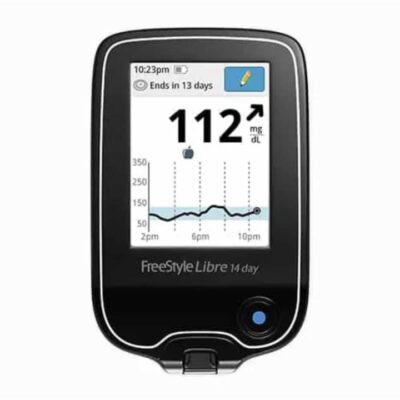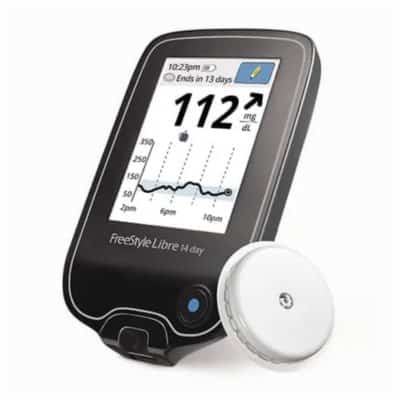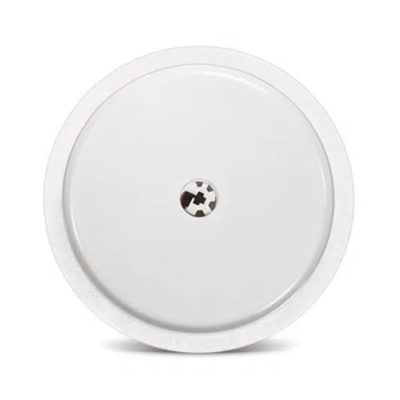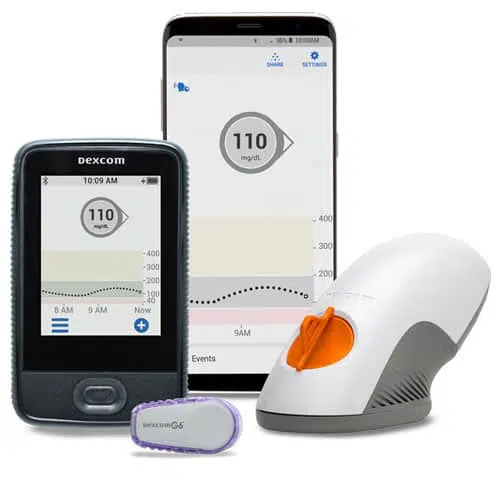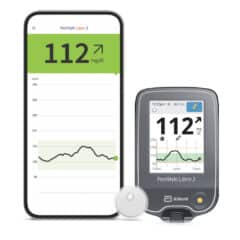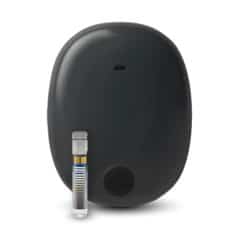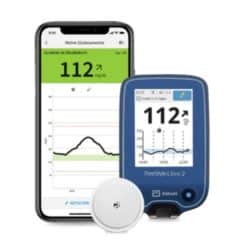
Abbott® Freestyle Libre 14 Day CGM System
The FreeStyle Libre 14 day system is a continuous glucose monitoring system consisting of a handheld reader and a sensor worn on the back of the upper arm which provides continuous glucose monitoring of your blood glucose levels essential for maintaining proper and levels in diabetes patients of all ages.
Advanced Diabetes Supply is a preferred distributor of the Abbott Freestyle Libre CGM.
Please call our Customer Care Team at 1-866-422-4866 or fill out the form below to see if you qualify for a continuous glucose monitoring system with $0 out-of-pocket costs.*
Abbott discontinued the FreeStyle Libre 14-Day System in January, 2021. Use the form below to see if you qualify for the FreeStyle Libre 2 or FreeStyle Libre 3 Systems.
Seamless Factory Calibration
In the past, the most state of the art blood glucose monitoring product took 45 seconds to work and took an enormous blood drop.
Factory calibration eliminates the need to prick your finger. FreeStyle Libre is the only product out there that has a factory pre-calibration.
Call ADS Customer Care at 1-866-422-4866 to order a CGM system that’s seamlessly part of your life and stop using painful fingersticks.
The FreeStyle Libre 14 day system is a CGM that consists of a reader which connect to a small sensor worn on the back of the arm. The sensor measures glucose in the interstitial fluid every five minutes and transmits these reading to your FreeStyle Libre CGM reader or smartphone.
Learn more about setting up your FreeStyle Libre CGM on the Abbott Freestyle site here.
A simple system without the use of painful fingersticks. Featuring 14 day wear and a fast 1-hour warm-up and easy to use scan provides real-time glucose readings for insulin dosing. A discreet sensor is easy to apply and now approved for up to 14 days
The only CGM able to maintain accuracy over 14 days without the need for fingerstick calibration or sensor coding. Factory calibration delivers clinically proven accuracy. The FreeStyle Libre 14 day system achieved a MARD of 9.4% over 14 days.
FreeStyle Libre and FreeStyle Libre 14 day Flash Glucose Monitoring systems are continuous glucose monitoring (CGM) devices indicated for replacing blood glucose testing and detecting trends and tracking patterns aiding in the detection of episodes of hyperglycemia and hypoglycemia, facilitating both acute and long-term therapy adjustments in persons with diabetes. The systems are intended for single patient use and require a prescription.
CONTRAINDICATIONS: Remove the sensor before MRI, CT scan, X-ray, or diathermy treatment.
WARNINGS/LIMITATIONS: Do not ignore symptoms that may be due to low or high blood glucose, hypoglycemic unawareness, or dehydration. Check sensor glucose readings with a blood glucose meter when Check Blood Glucose symbol appears, when symptoms do not match system readings, or when readings are suspected to be inaccurate. The systems do not have alarms unless the sensor is scanned, and the systems contain small parts that may be dangerous if swallowed. The systems are not approved for pregnant women, persons on dialysis, or critically-ill population. Sensor placement is not approved for sites other than the back of the arm and standard precautions for transmission of blood borne pathogens should be taken. The built-in blood glucose meter is not for use on dehydrated, hypotensive, in shock, hyperglycemic-hyperosmolar state, with or without ketosis, neonates, critically-ill patients, or for diagnosis or screening of diabetes. When using FreeStyle LibreLink app, access to a blood glucose monitoring system is required as the app does not provide one.
Review all product information before use or contact Abbott Toll Free (855-632-8658) for detailed indications for use and safety information. For full indications for use and safety information, see more here.
The beneficiary has diabetes mellitus; and
The beneficiary has been using a blood glucose monitor (BGM) and performing BG tests 4 or more times a day; and
The beneficiary is insulin-treated with 3 or more daily injections of insulin or is on a Medicare covered continuous subcutaneous insulin infusion (CSII) pump; and
The beneficiary’s insulin treatment regimen requires frequent adjustment by the beneficiary on the basis of BGM or CGM testing results; and
Within six (6) months prior to ordering the CGM, the treating practitioner has an in-person visit with the beneficiary to evaluate their diabetes control and determined that criteria (1-4) above are met; and
Every six (6) months following the initial prescription of the CGM, the treating practitioner has an in-person visit with the beneficiary to assess adherence to their CGM regimen and diabetes treatment plan.
How does the Freestyle Libre work?
The sensor uses a thin, flexible filament inserted just under the skin to measure glucose every minute.
How do you use The Freestyle Libre CGM?
Use the handheld reader to scan the sensor with a painless, 4 one-second scan to replace fingersticks.*
How is the sensor applied to the body?
The sensor is applied to the back of the upper arm with a simple, disposable device called an applicator. When the sensor is applied, a small (5mm) filament is inserted just under the skin, and held in place with a small adhesive pad. Most patients don’t feel pain when applying the FreeStyle Libre sensor.*
Is it necessary to apply a sensor in a different location if I feel discomfort or in case of a mis-application?
To prevent discomfort or skin irritation, you should select a different site other than the one most recently used.
When applying the sensor to my arm, do I need to stretch or pinch the skin?
No, there is no need to stretch or pinch the skin to apply the sensor. The sensor should be applied only on the back of your upper arm. Avoid areas with scars, moles, stretch marks, or lumps. Select an area of skin that generally stays flat during normal daily activities (no bending or folding). Choose a site that is at least 2.5 cm (1 inch) away from an insulin injection site. To prevent discomfort or skin irritation, you should select a different site other than the one most recently used. For more information please refer to the FreeStyle Libre User’s Manual.
How Do I Keep My CGM Sensor From Falling Off?
Cover the sensor with a CGM securement patch like the RIghtCare CGM Patch, made with KT Tape Pro Extreme.
Will the user feel the sensor while wearing it?
The portion of the sensor that gets inserted under the skin is less than 0.4 millimeter wide (1mm is about the thickness of a few strands of human hair) and it’s inserted only about 5mm under the skin, so most people will not feel the sensor while it is being worn.*
Were there any skin reactions reported by patients wearing FreeStyle Libre sensors?
Mild skin irritations, such as erythema, edema, rash, bleeding, itching, induration, and infection were reported around the insertion site and adhesive area by a moderate frequency of subjects (5 out of 48 or 10.4%).*
Can users bathe, shower, swim or exercise while wearing a sensor?
Yes. The sensor can be worn while bathing, showering, swimming or exercise. The sensor should not be taken below 1 meter of water (3 feet), and should not be submerged in water for more than 30 minutes. The adhesive is designed to keep the sensor securely and comfortably in place for up to 10 days after the start-up period.
How long can the sensor be worn?
The disposable sensor is designed to adhere to the back of the upper arm and provide accurate glucose readings for up to 10 days after the start-up period. After the 10 days, the user removes the sensor by peeling off the adhesive pad.
How do you remove the sensor?
Pull up the edge of the adhesive that keeps the sensor attached to the skin. Slowly peel away from the skin in one motion. Note: Any remaining adhesive residue on the skin can be removed with warm soapy water or isopropyl alcohol.
What if the user needs to remove the sensor before 10 days (or if it falls off)?
Users should remove the sensor and start a new sensor. The reader will identify that it is a new sensor and ask users if they want to start it. If a sensor falls off before 10 days have completed, then the user should call Customer Service at 1-855-632-8658.
What Do I Do If My FreeStyle Libre Sensor Falls Off Or Is Damaged?
If this happens to you, contact Abbott (the manufacturer of these CGM systems) here for a free replacement. Abbott’s customer service department is available from 8 a.m. to 8 p.m. Eastern on all days except holidays.
*For qualified persons with applicable in-network insurance and subject to CGM coverage requirements. Deductibles, co-pays, and other conditions apply. Speak to an ADS representative and your insurance company to confirm your coverage and costs.
